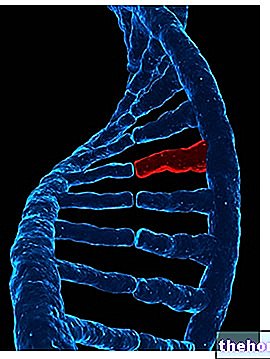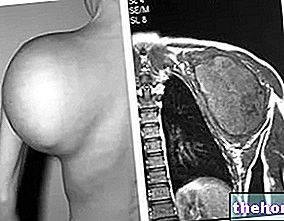As benign tumors, fibroids are masses of cells with an abnormal "proliferative activity, which however do not infiltrate the surrounding tissues and are not even metastatic.
As will be seen later, there are many varieties of fibroid.
To understand: What is Fibrous Connective Tissue?
Also known as dense connective tissue, fibrous connective tissue is a variant of connective tissue in which the share of type I collagen fibers is particularly relevant (collagen is a protein).
The formation of fibrous connective tissues is the result of the activity of cells known as fibroblasts.
Generally, the fibrous connective tissue has a support function: it constitutes the tendons, which serve to connect bones and muscles; it composes the ligaments, which serve to join some bones; offers support to internal organs; constitutes the dermis, which is the deepest layer of the skin.
Fibroma: who does it affect?
Anyone can develop a fibroid; however, it should be noted that there are: fibroids that affect children more frequently (eg: non-ossifying fibroid); fibroids that only affect women (eg uterine fibroid); most common fibroids in one of the two sexes (eg: angiofibroma more often affects males); fibroids typical of adulthood (eg ovarian fibroma); fibroids observed in young people and adults with the same frequency (eg dermatofibroma).
Can Fibroma Become a Malignant Tumor?
Although rarely occurring, certain forms of fibroid can evolve and become malignant tumors; the malignant version of the fibroid is fibromasarcoma.
As is typical of malignant tumors, fibrosarcomas are tumors characterized by a high rate of growth and proliferation.
, ovaries, kidneys, bones, cartilage, skin, subcutaneous tissues, stomach and intestines; it should also be noted that the fibroid can also affect the nerves and mucous membranes of the oral cavity., histology, location, size, etc.
Hard fibroma
Hard fibroids are characterized by an important share of collagen fibers and low levels of fibroblasts.
The best known example of hard fibroid is dermatofibroma, a benign skin tumor.
Soft fibroma
Soft fibroids, on the other hand, are characterized by a significant amount of fibroblasts and low levels of collagen fibers.
The most important example of a soft fibroid is the pendulous fibroid.
Uterine Fibroma or Myoma

A well-known variant of fibroid and of enormous interest to the female population is the uterine fibroid.
Also called myoma, uterine fibroid is a very common benign tumor of the uterus, found mainly in women between the ages of 30 and 40.
Depending on the position occupied in the "organ of" interest, the uterine fibroid can be:
- Submucosal: the submucosal fibroid is located on the inner wall of the uterus, where the endometrium extends.
- Subserous: the subserous fibroid takes place on the external wall of the uterus, connected to the latter by means of a peduncle or a filament.
- Infringement: the infralegamentary fibroid resides between the two sheets of the uterine ligament.
- Intramural: the intramural fibroid is found in the internal muscular wall of the uterus, a wall which, due to the presence of the tumor, undergoes a deformation.
Uterine fibroid can be responsible for symptoms such as: hypermenorrhea (heavy periods), blood loss between two menstrual periods, pelvic pain, frequent urination and dyspareunia (pain during sexual intercourse); moreover, in some cases, it can cause infertility.
For further information: Uterine Fibroma: What it isPendulous fibroma or cutaneous fibroma
Also known as acrochordon, leeks, and skin fibroids, skin tags are pedunculated skin growths that protrude outward.
Pendulous fibroids can form anywhere; however, they show a preference for areas subject to continuous stress and rubbing, such as the armpits, neck, groin and upper eyelids.
Currently, the precise cause of the pendulous fibroma is not yet known; epidemiological data, however, suggest that factors such as obesity, hyperglycemia, hyperinsulinemia, acromegaly and female sex favor its appearance.
For further information: Pendulous Fibroma: What it is and TherapyDermatofibroma
Also known as histiocytoma, dermatofibroma is a fibroid that originates from the fibrous connective tissue of the dermis.
Currently, the precise cause of dermatofibroma is unknown; c "there is a strong suspicion, however, that this benign skin tumor is the result of an abnormal reaction to minor trauma, such as the sting of a thorn or an insect.
More common among adults and women, dermatofibroma can present as a single lump, visible on the surface of the skin, or as a multiple lump.
The areas of the body of greatest interest are the lower and upper limbs.
Other Types of Fibroma
Among the various types of fibroid, there are:
- Ossifying fibroma: is a benign bone tumor, typically found in the jaw.
Characterizing ossifying fibroma is a process of replacing bone tissue with fibrous connective tissue. - Non-ossifying fibroma: is a benign bone tumor, which mainly affects long bones such as the femur, tibia and, although less frequently, those of the lower limbs.
Non-ossifying fibroid mostly affects children, especially boys. - Ovarian fibroma: is a rare benign tumor of the ovary, found mainly in middle-aged women (50 years), which usually presents as asymptomatic.
- Myxofibroma: it is a benign odontogenic tumor, characterized by the presence of myxomatous tissue in addition to the typical elements of the fibroid, which typically appears at the level of the maxilla or mandible.
- Angiofibroma: is a benign vascular neoplasm, consisting of fibrous connective tissue and blood vessels.
It typically appears in the nasopharynx, near the adenoid (nasopharyngeal angiofibroma).
By itself, angiofibroma is not dangerous, but it is still aggressive due to the location in which it usually develops. - Neurofibroma: is a benign fibroma that affects the nerves or tissues of the peripheral nervous system; it is visible on the surface of the body, as it is responsible for characteristic skin protuberances.
- Renal fibroma: Also known as medullary fibroma, this is a benign tumor of the kidney that arises from the interstitial cells of the renal medulla.
Typically, his diagnosis is random. - Desmoplastic fibroma: This is a rare benign bone tumor that mainly affects children and young adults.
Despite being a benign neoplasm, the dermoplastic fibroid can be aggressive, as it is capable of causing the destruction of the cortical portion of the bones (in which it is formed).
The bones usually affected are those of the splanchnocranium, the humerus, the femur and the tibia. - Desmoplastic fibroblastoma: it is a benign tumor usually subcutaneous, involving the aponeurosis of the muscles or the same muscles located on the extremities of the limbs, on the shoulder girdle, on the pelvic girdle or on the neck.
- Nuchal fibroma: it is a subcutaneous and dermal fibroma, containing, in addition to the classic elements, adipocytes and nerve cells.
As the name suggests, nuchal fibroma develops mostly in the neck; however, it could also appear on the extremities of the limbs, in the lumbosacral area, on the face and on the buttocks. - Chondromyxoid fibroma: it is a fibroid that concerns the cartilage tissue; it is a rare benign neoplasm, which covers less than 1% of bone tumors.
- Traumatic fibroma (or fibroma of the mouth): it is a benign tumor that affects the mucous membrane of the mouth and which usually appears as a result of irritative phenomena.
Finally, the importance of monitoring all those forms of fibroids potentially at risk of a malignant evolution should be emphasized.
Only with an accurate diagnosis can the most appropriate treatment plan be defined in detail.
, the carbon dioxide laser, the pulsed laser and the radiofrequency ablation.Fibroma: is it always to be treated?
Not all fibroids need treatment; this is the case, for example, of asymptomatic fibroids with no repercussions as regards the patient's quality of life.
Uterine Fibroma: the Cure
Possible treatments for uterine fibroid include:
- Laparoscopic myomectomy: is the surgical removal of the uterine fibroid performed through three small incisions at the abdominal level.
Minimally invasive, laparoscopic myomectomy preserves the uterus; therefore, if the patient is still of childbearing age, she may still have children. - Laparotomic myomectomy (or abdominal myomectomy): is the surgical removal of the uterine fibroid performed through an "important incision in the abdomen".
Like the previous therapeutic option, laparotomic myomectomy also preserves the uterus and the fertility of any patient still in age to have children. - The hysterectomy: is the removal of the uterus.
This solution is suitable for postmenopausal women (who can no longer have children) and for patients with large uterine fibroids (even if of childbearing age). - Embolization: involves the injection of special embolizing agents, which have the effect of interrupting the blood supply destined for the uterine fibroid; not receiving more blood, the latter first becomes smaller and subsequently undergoes necrosis.
The disadvantage of this solution is that, at times, it can happen that embolizing agents interrupt the flow of blood to the ovaries or other nearby organs. - Endometrial ablation: is a therapeutic solution applicable in the presence of submucosal uterine fibroids (ie located on the inner lining of the uterus).
From a practical point of view, endometrial ablation involves the introduction into the uterus of a particular instrument that can emit heat, hot water or electric current. - Radiofrequency ablation: is a technique that allows you to destroy uterine fibroids and narrow the blood vessels that feed them.
There are two ways to perform radiofrequency ablation: by laparoscopy or by transcervical route. - Focused ultrasound under the guidance of magnetic resonance imaging (MRgFUS): is a very recent technique for treating uterine fibroids, which uses magnetic resonance images to concentrate an ultrasound beam in the exact point where the tumor mass resides; this ultrasound beam has the ability to destroy the uterine fibroid without damaging the skin (which it crosses to reach the desired area) and other surrounding tissues.
MRgFUS is appreciated above all for its minimal invasiveness. - Pharmacological therapy: includes various solutions, including gonadotropin-releasing hormone agonists (eg: leuprolide, goserelin, triptorelin), progestin-releasing IUD and birth control pill.
The aforementioned drugs do not eliminate uterine fibroids, but allow you to control their symptoms.




























